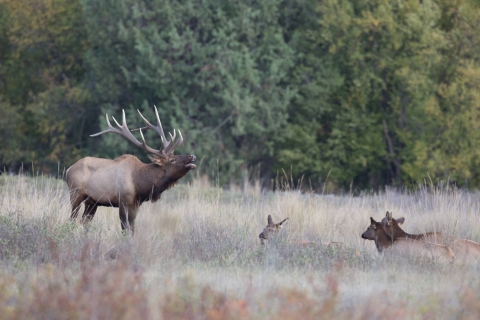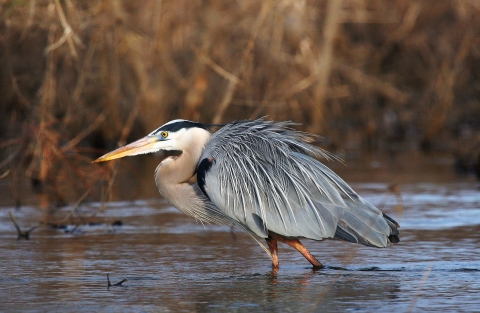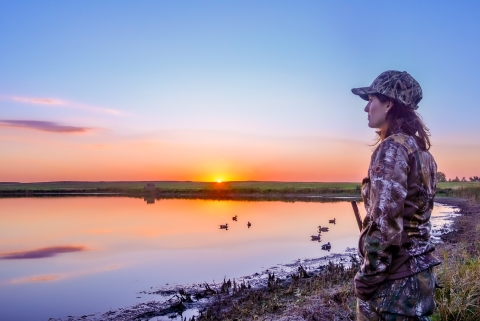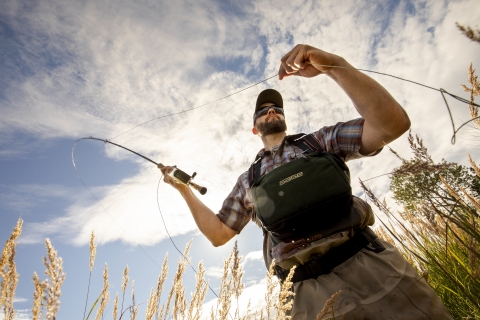Facility Activities
Wildlife Observation
If you enjoy being outdoors and looking for wildlife, consider a visit to Ouray National Wildlife Refuge! From birding to viewing speedy pronghorn or slow-moving porcupines, wildlife observation is the most popular activity for Refuge visitors.
An auto tour road crosses through a variety of Refuge habitats providing excellent wildlife viewing. Visitors traveling this route will have opportunities to see ducks, geese, cranes, herons, and a variety of shorebirds in the Refuge wetland areas. The road meets the river where red-tailed hawks, bald eagles, great horned owls, songbirds, and porcupines may be seen in the cottonwood and willow trees. As the tour route travels up the clay bluffs onto the grasslands, white-tailed prairie dogs and pronghorns may be seen along with western meadowlarks, sage sparrows, and black-tailed and white-tailed jackrabbits.
Spring and fall provide opportunities to see Canada geese and mallards. Species such as red-winged blackbirds, American goldfinches, horned larks, and savannah sparrows may also be seen in the croplands. Look for bald and golden eagles perched on nearby cottonwoods hunting for smaller bird and mammal species. From September through November mule deer and elk become more active and easier to see.
Hunting
Hunting is an important wildlife management tool that we recognize as a healthy, traditional outdoor pastime, deeply rooted in America’s heritage. Hunting can instill a unique understanding and appreciation of wildlife, their behaviors, and habitat needs. As practiced on Refuges, hunting, trapping and fishing do not pose a threat to wildlife populations, and in some instances are necessary for sound wildlife management. For example, because predator numbers are greatly reduced, deer populations will often grow too large for Refuge habitat to support.
Hunting on Ouray National Wildlife Refuge is permitted for ducks, geese, coots, pheasants, sandhill cranes, deer, elk, pronghorn and turkeys in designated areas with season and weapons restrictions. To find more information about hunting at Ouray National Wildlife Refuge, download the Hunting and Fishing Regulations or call Refuge staff at 435-545-2522. For information on Utah State hunting licenses, seasons, and regulations please visit the Utah Division of Wildlife Resources website.
Fishing
In addition to the conservation of wildlife and habitat, the Refuge System offers a wide variety of quality fishing opportunities. Fishing programs promote understanding and appreciation of natural resources and their management on all lands and waters in the Refuge System. For a great place to reconnect with a favorite childhood activity or to try it for the first time, make plans to fish at Ouray National Wildlife Refuge soon. We have an accessible fishing pier on the Sheppard Bottom auto tour road. Most of Utah and the Refuge's fish species are non-native fish. The main fish to be caught in the Green River is channel catfish, but there are several other non-native and native fish species as well. Please be aware that razorback suckers, Colorado pikeminnows, humpback chub and bonytails are endangered fish species found in the river and must be returned to the river unharmed if accidentally caught.
Ouray National Wildlife Refuge fishing regulations and locations can be found in our Hunting and Fishing Regulations brochure. Find more information about fishing on National Wildlife Refuges with our online Guide to Fishing for the First Time. To find information regarding Utah State fishing licenses, limits, and more, please visit the Utah Division of Wildlife Resources fishing page.
Interpretation
Ouray National Wildlife Refuge interpretation programs provide opportunities for visitors to make their own connections to the natural world. From self-guided walks to ranger-led programs, we help visitors connect to the wildlife and habitat behind the landscapes. Please call the Refuge office to ask about staff availability at 435-545-2522; or email ouray@fws.gov.
Check out the Visitor Center and learn about the Green River and the plants and wildlife you may see on the Refuge. Exhibits include skulls, skins, antlers, bird nests, eggs, feathers, and bird calls. There are also displays about the history of the area. Posters and brochures, including bird, butterfly, and plant lists for the Refuge, are available. The auto tour road also includes a series of interpretive signs about Refuge habitats and wildlife.
Environmental Education
The staff at Ouray National Wildlife Refuge knows that one of our most important roles is as an outdoor classroom to teach about wildlife and natural resources. We offer environmental education programs for a variety of audiences and host school groups for Refuge tours.
Is your school, youth, environmental or other group interested in learning more about the wildlife, plants, habitats and ecology of Ouray National Wildlife Refuge? Refuges are wild places, and we want to teach you more about them! Please call the Refuge office to ask about staff availability at 435-545-2522; or email ouray@fws.gov.
Photography
Nearly 12 million people visit outdoor areas each year to photograph wildlife, and national wildlife refuges naturally are at the top of the list. Ouray National Wildlife Refuge provides excellent opportunities to photograph wildlife in natural habitats by providing a platform, a viewing tower, brochures, viewing areas, and a tour route. Wildlife photography is a high-priority activity in the National Wildlife Refuge System and we welcome beginning and expert photographers alike!
Other Activities
- Hiking is permitted on the Refuge aside from the "farm fields", which are signed. Sheppard Bottom has a primitive 1.3 mile walking trail which can be accessed from the auto tour road.
- Biking
- Horseback riding
- Canoeing, rafting, and motorized boating are permitted on the Green River. Non-motorized boats may be used in wetland areas.
- Please note that off-road vehicle travel is prohibited.





